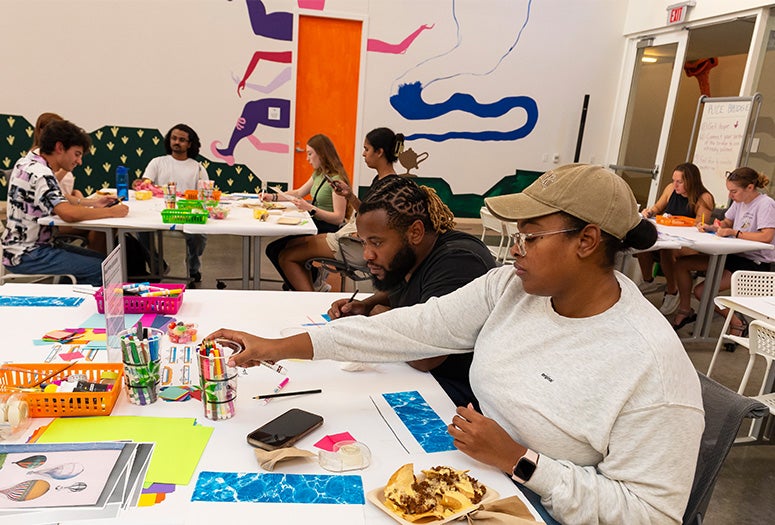Rice University’s Moody Center for the Arts recently hosted the first undergraduate social for engineering students, bringing together students from across different engineering departments for an afternoon of fun activities, including art-making stations, door prizes and free food.

Favour Williams, a senior majoring in mechanical engineering, said he came to the Moody because he enjoys “appreciating and admiring art.”
“I think there is an intersection between art and engineering ⎯ they both involve making, and the best engineering products and engineers share something in common with artworks and artists,” Williams said.
The event builds on a growing collaborative momentum between the Moody and the George R. Brown School of Engineering and Computing. The collaboration has reached a new milestone this year with a special iteration of “The Bridge Project” ⎯ a multiyear project by internationally renowned Korean artist Do Ho Suh that explores the meanings of home, distance and diaspora. As part of their senior capstone design project, three civil and environmental engineering students worked with the artist to help bring his aesthetic vision to life.
Suh tapped the students’ skill in structural engineering in order to build conceptual bridges between his homes in Seoul, South Korea, New York and London. The collaboration challenged the students to balance technical requirements with aesthetic vision and to think beyond the purely functional aspects of their designs. The project is part of an exhibit titled “Do Ho Suh: In Process,” which is currently on view at the Moody.
“The artist Do Ho Suh met with the student team throughout the academic year, collaborating with them to design three buildable bridges that could actually be constructed and would meet certain structural parameters such as surviving the extreme Arctic waters without harming the environment, while also featuring a design aesthetic that would align with the artist’s point of view,” said Alison Weaver, the Moody’s Suzanne Deal Booth Executive Director and curator of the exhibit. “My personal favorite of the student-designed bridges is based on the structural principles of origami.”

Weaver said that the primary mission of the Moody is to “serve as a platform for interdisciplinary encounters.”
“Art helps us see the world differently,” said Weaver. “This idea of creating a space that’s more open and fluid, less structured and didactic than a traditional museum or a classroom, is central to the mission of the Moody. We would love to do more with engineering. This has been a breakthrough year in terms of this growing collaboration.”
By curating exhibitions that intersect with scientific and engineering research interests, the Moody seeks to tease out how research and artistic practice can inform and elevate each other. One upcoming exhibit focused on sustainability will further expand this interdisciplinary partnership.
The Moody has also played a role in bringing art into engineering spaces. Its oversight of the Rice Public Art collection includes artworks specifically chosen to resonate with the scientific research conducted on campus. These works include two new commissions and one acquisition sited in the Ralph S. O’Connor Building for Engineering and Science: Rafael Lozano-Hemmer’s “Climate Parliament,” Tomas Saraceno’s “Crux Australis 68.00” and Erick “Snowfro” Calderon’s “Chromie Squiggle #9950.”
Co-organized by Erica Harris, program administrator in the civil and environmental engineering department, and Lauren Cross, associate director of academic and public programs at the Moody, the engineering social sought to further familiarize students with the resources and experiences on offer at the Moody in hopes of encouraging further collaboration between art and engineering at Rice.

“Even though we are on different sides of campus, we have a lot of thematic connections and a lot of students that are interested in both art and engineering,” Cross said.
Hands-on experience is one such point of resonance between art and engineering. Spending time in the Oshman Engineering Design Kitchen ⎯ a space where engineering undergraduates get to design and prototype solutions to real-world engineering challenges ⎯ is a rite of passage for Rice engineering majors. The Moody Makerspace, which is available for undergraduate and graduate students as well as faculty in all fields of study, is a complementary site for hands-on experience on campus that includes a wood shop, metal shop, rapid prototype and paint booth, and offers workshops on 3D printing, laser and vinyl cutting and more.
The organizers thanked Rice Housing and Dining for its support and said that they hope to make the engineering social a yearly event.
“Collaboration is inevitable, both in the arts and in engineering, and that is part of why it makes sense to put these two forms of practice in dialogue,” Harris said.

